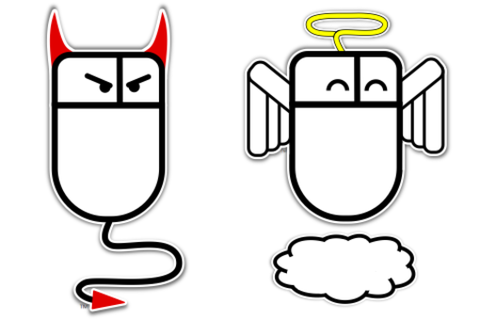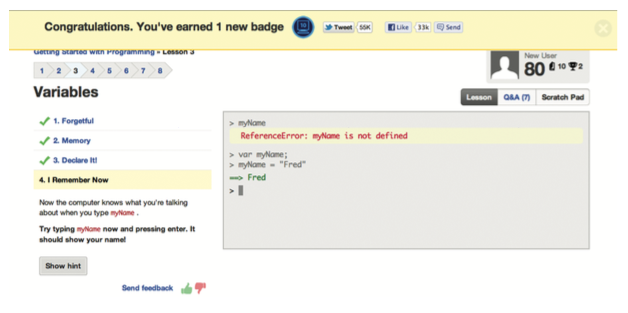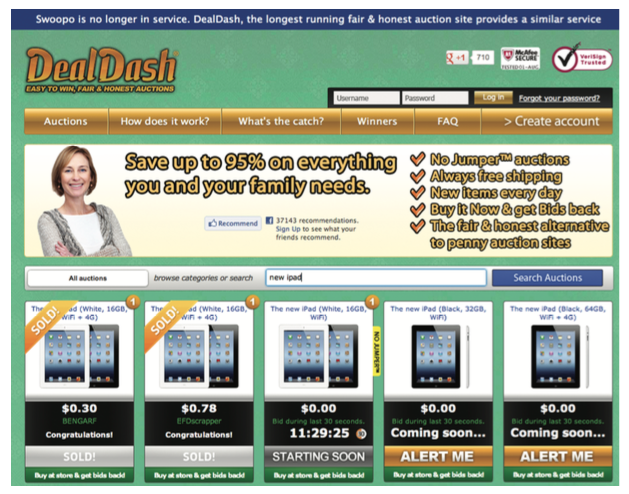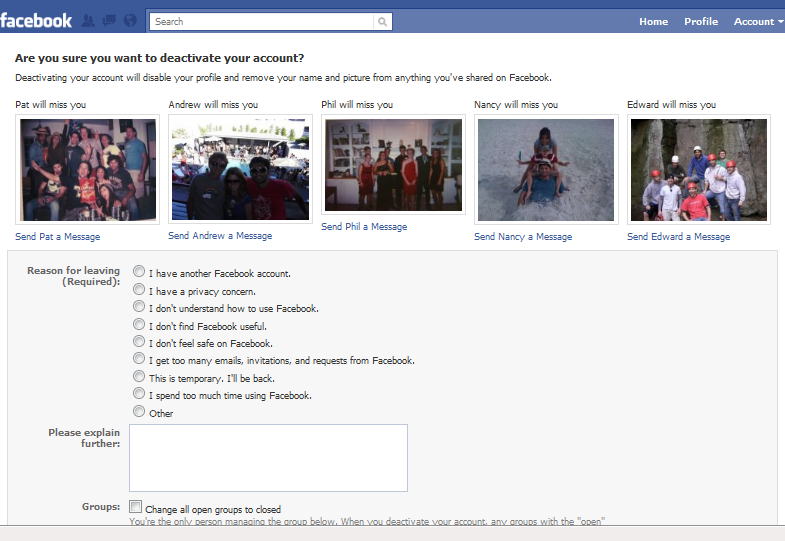Evil by Design: interfaces from Mephistopheles (part one)
Chris Nodder, author of the book " Evil by Design ", immediately inspires confidence. Not so much with his track record of advances in psychology UX design and consulting, as the obvious ability to cling and sell. In fact, under a stylish cover with a demon girl is a collection of consumer manipulation techniques, many of which have been known for a long time. But, you see, “a guide for a designer who serves Evil, evoking dark instincts in people” sounds much more exciting. Let's push the consumer to deadly sins!

Why deadly sins? Because they all describe the usual behavior of the average person, highlight those points that are easiest to push. After all, if people did not fall into the temptation of precisely these qualities, there would be no reason to forbid them. By understanding what psychological characteristics are behind each of the sins, we achieve a better understanding of human nature, and this is the key to creating a good design. Well, if someone is curious, but ashamed, then this book can be read from the point of view of the user: to counter the amoral game on our weaknesses, you need to be able to recognize the appropriate mechanisms.
')
As you may have guessed, the techniques in this book are divided into blocks corresponding to the seven deadly sins: pride, laziness, gluttony, anger, envy, lust and greed. Each chapter provides a psychological rationale for this type of behavior, ways to use it in interfaces for motivation to action, and examples of real companies consciously or unconsciously applying these methods. Under the cut you will find a summary of the first three chapters, which deals with pride, laziness and gluttony.

Nowadays, few people perceive pride as a negative quality, but in some cases it becomes a weak point. People usually value their reputation so much that they are ready for self-deception, so as not to lose face and stay right in their eyes and for those around them.
The cognitive dissonance
Cognitive dissonance occurs when two concepts come into conflict in our minds. The state is unpleasant precisely because it forces one to admit: one of the judgments was wrong and needs to be revised. To avoid this, we often come up with some kind of rationalization (sometimes quite strange) that seems to eliminate the contradiction.
For users, the source of cognitive dissonance is often the buyer's remorse (I really want to buy it + you can't waste money = conflict). Accordingly, the sites provide everything to help people convince themselves that the purchase is profitable and necessary, and thus resolve the conflict.
Arguments can serve:
The last two points require more subtle, indirect methods: the selection of appropriate graphics, competent writing texts. At the same time, it is important that the same message be traced everywhere: on different pages of the site, in advertising, in documentation.
Social justification
Pride makes us worry about how we look in the eyes of other people. We model our behavior based on the concept of the norm. And the norm is what others do.
Therefore, in order to push the user to a solution, it is useful to place messages about your product on several sources that he trusts. It is desirable that they do not just repeat, but paraphrase and complement each other, and appear on third-party, neutral sites. This especially affects buyers who come for the first time or rarely deal with your area.
Popularity markers also look very convincing: the number of purchased / remaining copies, the “goods out of service” tags, information that other users are viewing the product page, statistics. You can involve stereotypes associated with the product, use associative links (everyone who does X consumes Y).

Apple fans are waiting for the release of iPhone 6 and at the same time suggest passers-by
On the other hand, mentioning people who do not do what you need is always a risk. Even if you explain why they are wrong, their very presence may prompt the user to follow suit. A good illustration of this was one anti-alcohol campaign for teens. The organizers mentioned in the text what a huge percentage of minors are addicted to drinking, trying to impress the audience, but they only achieved what teenage viewers understood: it is fashionable to drink now.
Personal messages
For social justification is important not only what is said, but by whom. Most of all we trust people with whom we are intimately familiar with, so the recommendations that come from them (or supposedly from them) usually give the desired effect.
This tactic is very widely used in social networks, which do not accidentally tell us about every action of our friends. For example, notes like “such and such like this post” on Twitter create a feeling that our friends actively recommend that we also click on a heart. Some services go further and present the action as something interactive, directed at us and demanding a response. Here you can recall Google+, which formulates a notice that someone has brought our e-mail in his circle, as “someone invited you to Google+,” because when an acquaintance invites, it’s inconvenient to refuse.
Announcement of choice
Falling in their eyes is still half the trouble, the main thing is that others should not know about the error. We do not like to loudly admit that we were wrong. If the choice of the user becomes known to other people, he will be less inclined to change his mind. Many applications that help users achieve some goals (for example, lose weight or learn a language), build motivation on this.
There are several ways to achieve publicity: ask for access to social networks, create your own platforms for users to communicate, divide users into groups according to their activity or involvement with relevant markers.
Underline similarities
Another feature of human thinking is called the propensity to confirm their point of view. We unconsciously filter and interpret the information so that it confirms the opinions we hold.
A great way to feed users to a message is to surround it with theses, with which the target audience is likely to agree, and show how one follows from the other. Of course, there is always the danger of not guessing what visitors would agree with. Therefore, preference is usually given to banalities - universal values and aspirations shared by the majority (love of family, healthy lifestyle, thirst for success and self-realization).
Similarly, calls to action work better if you do not convince people to change their habits, but to show that they themselves already partially do what you are trying to achieve from them.
Certification as a guarantee of reliability
A / B tests show that a blind promise of any guarantees significantly increases the level of conversion of the site. Referring to an authoritative source in connection with security issues causes the visitors a sense of reliability (as practice shows, unfounded). It is worth considering the option of obtaining or creating a certificate that most cares about users: a refund, data security, service reliability. Demonstrating such logos is better not on every page, but at strategic moments when the user is just determined with the decision.
Striving for completion
Uncertainty causes tension and irritation, and the consciousness that the process is complete, on the contrary, brings satisfaction. If this cannot be achieved in a natural way, people are ready to deceive themselves by creating artificial "finish lines." Also, the ability to bring things to the end is approved by society as a sign of organization and strong will.
This desire to go all the way is based on those retention schemes that offer a small amount of services for free, and the rest for a fee. The fee does not have to be cash, it can be time or certain actions. This tactic is especially effective when all the achievements of users are placed on a scale that clearly shows how much they have already advanced and how many stages remain.

You now have one icon. I wonder how many there are?
A good example of playing this feature is how social networks push users to add personal information. Strictly speaking, this is not a prerequisite for using the site, but constant reminders that the profile is filled only "by 25%" implicitly exert pressure, creating the feeling that the business has begun and is not over.
In addition to completeness, people have a craving for order. If there is some disharmony in the interface (say, a gap in the place of missing information), which is easy to fix, most likely they will do it.

Laziness is the reluctance to make an effort or indifference to the outcome. On the Web, it manifests itself in the fact that users strive to perform a minimum of actions to achieve a goal and refuse to interact with the site if it requires too many gestures.
Minimum barriers
Custom travel must take the path of least resistance. Usually people browse the pages, following the F-pattern: browse the title part and glance from top to bottom, stopping and moving in, once some content will interest them. Key information should be located in the “hot” zones, what you want to hide - in the “dead”. If it is necessary to knock a user off the beaten path, bright, attractive objects (bright buttons, banners, graphics) can help.

Visualization of “hot” and “dead” zones on the screen
Another tactic of hiding information is mimicry for informational noise. Users are trained to ignore certain types of content, such as advertising or legal documents. Therefore, if the text is located where people expect to see a banner ad, or merges with links to a privacy policy, few people will read it.
An important turning point on the page is a call-to-action button. It should be bright and clearly signed to motivate the visitor to move on. Keep in mind that with all that is under it, the user with a high degree of probability simply will not reach.
Easier choice
It has long been known that an excessively wide choice paralyzes, overstates expectations and makes it difficult to make a decision. People are too immersed in the selection process and are often frustrated by the result, which cost them so much effort.
The easiest way out is to cut the number of options. However, the range still needs to remain fairly wide: users associate this with a high level of expertise. Filters and recommendation systems will help meet both requirements. Try to group the parameters so that visitors do not have to compare products at once across several.
Here the reverse logic also works: if you want the users to appreciate their decision better and not to abandon it later, make them make a choice (even if it is purely formal, from a narrow set of options that suit you).
Thanks to the priming effect, users respond better to what they are familiar with from past experience. Therefore, you should take care that the first they caught the eye the best option. This rule is relevant both for the interface of your product (all lists should be the first to have the best option already checked) and for external sources (if advertising banners mention a particular product or service package, new visitors will go to the site search for him).
More sophisticated priming techniques are related to brand image creation. How it works, we all know: if a commodity is “heard”, our memory will tell us about it when the time comes and make a choice, and it will eliminate the need to think further.
Complication of failure
Many companies do go further and make a choice for the user by default - in order to change the situation, he must take active steps (check profile, change settings). Considering that most people are lazy about keeping track of updates and reading user agreements, they may not even suspect that they passively agree to some conditions.
A classic example of the use of such tactics is the predetermined arrangement of check marks in registration forms. The force of inertia often keeps visitors from reading, understanding and making some changes. An additional trick is the use of negative constructions, in which consent is considered as the default option, and refusal - as specially negotiated. Simply put, feel the difference between the "I want to receive newsletter about company news" and "I do not want to receive newsletter about company news."

Do you remember the day you got McAfee? That's it.
A similar method is to disguise an additional offer under the next step in the process to which the user has already agreed (for example, making a buyer's card when buying, installing third-party software when downloading a file). Strengthen this illusion with a text button like "Continue" or "Next."
In case the user decides to take the initiative, the management of the settings is made deliberately confusing, so that it would be more difficult to refuse the service. The complexity can be achieved by heavy, abstruse texts, vague navigation, a cumbersome system of settings.

About gluttony can speak in cases where consumption exceeds reasonable limits. Such a model of behavior develops when self-control is turned off and emotional reactions overlap with rational evaluations.
"You deserve it."
In the prevailing culture, it is not a shame not to know the measures, so you can move people to gluttony with the magic words “you deserve it”. To make the formula sound convincing, you need to present bonuses that customers receive (coupons, discounts, gifts) as a reward for the work they have done. This idea underlies many gamification schemes. After the user has performed some actions in exchange for a bonus, he feels not only entitled, but practically obliged to use it.
Here it is important to maintain a balance: if it is too difficult to get a reward, laziness will win. But by requiring relatively little effort and recalling the labor invested, it is possible to significantly increase the value of the proposal in the eyes of users. By the way, the value does not have to be big. Paradoxically, with little benefit, people invest more emotionally - because they have to find excuses for overcoming cognitive dissonance.
Hidden numbers
If it becomes difficult to objectively evaluate a proposal, users would rather rely on the first emotional reaction. So, it is necessary:
It is possible to create the feeling that a purchase is profitable without understating the price, due to the difficulty of calculations. It is achieved in different ways:

iPad for only thirty cents (+ everything you spend on auction chips)!
Recognition of flaws
Any product has flaws, and sooner or later customers will find out about them. Talking about some of them at once, you gain confidence by showing yourself to be honest people who have nothing to hide. This is also a kind of disabling self-control.
Naturally, the flaws advertised are selected so that they can immediately be balanced with something - otherwise users will not be able to justify a purchase for themselves. Having mentioned some kind of minus, immediately bring the relevant strength that smoothes it (i.e., “our lamps are more expensive, but they work longer, allowing you to save in the long term,” not “our lamps are more expensive, but give a brighter light ").
What to do if a company is faced with an incident that could jeopardize customer trust? Oddly enough, the best strategy here is frankness and communication. If the error is serious and affects a large number of users, you should not try to silence it or disclaim responsibility. On the contrary, it is necessary to work actively to eliminate the consequences, demonstrating competence, honesty and goodwill.
Build up engagement
The trick is old as the world, it was also used by distributors of goods that went home: get the client to agree to some trifle, and then it will be much easier for you to persuade him to do something more substantial for you.
In an online environment, the question of something insignificant (for example, a zip code) under the pretext of customization of the service can be in the role of the initial “hook”. The transition from zero to low involvement is always the most difficult, so the request should be very unassuming. Then, as you interact with the product, you can gradually and carefully increase the scale of requests, thereby increasing engagement.
If there has been some time between requests, it will not be superfluous to remind the user about the history of your relationship in order to set it up in the desired fashion.
No matter how funny, the opposite strategy works - lowering requirements. Sometimes it is necessary to openly rush and get a refusal, in order to then put forward a much more modest request, which the client will already be embarrassed to refuse. This is explained by the fact that people tend to show reciprocity, that is, to respond to some attitude with a corresponding attitude. From their point of view, you make a concession, respectively, they do the same.
However, the success of this technique depends on several conditions:
In the online environment, there are difficulties with the first item: the user will not experience guilt, refusing the interface. Therefore, it is necessary to introduce additional measures: to formulate the initial proposal with empathy (to recognize that the request is really significant) and to give the opportunity to easily and quickly refuse it, not too distracting from the journey.
Tom Sawyer effect
People really do not like to lose something of value. This also applies to what they have at the moment, and the hypothetical benefits that they can receive. The idea that they might not get some kind of product or service greatly enhances its value in their eyes and breaks self-control.
To excite interest in a product, present it as:
- rare
It is possible to create the feeling that the buyer has the only chance to purchase the product due to the limited period of sale.
- exclusive
Emphasize that the offer is only available for a specific group of people.
- causing competition
Demonstrate that the product is popular, there are many others who want to buy it. Here again quantitative metrics will be useful: how many goods are left, how many views are on the page with the offer.
Talking about the value of the product is necessary not only before the moment of purchase, but also when trying to refuse the service. A reminder of what he is losing will cause the user to fear losing and may cause him to change his mind.

Facebook makes the user look into the eyes of all those who “will miss him” before deleting an account
Compliant from the rush
The fear of missing the benefits becomes especially acute when the feeling of time pressure is added to it. Hard time frames serve as a trigger for several psychological effects. First, there is a feeling of panic, which reduces the ability to rationally think and choose. Secondly, the desire to bring the case to the end generates excitement. Thirdly, the proposal is perceived as limited, and therefore valuable.
As a result, a person, hurrying to complete the process, most often agrees to everything that the system offers him by default. And this, as we remember, is the most profitable options for the company. Such a scheme is often used on sites for booking tickets, where impatience is spurred on by objectively high competition.

Why deadly sins? Because they all describe the usual behavior of the average person, highlight those points that are easiest to push. After all, if people did not fall into the temptation of precisely these qualities, there would be no reason to forbid them. By understanding what psychological characteristics are behind each of the sins, we achieve a better understanding of human nature, and this is the key to creating a good design. Well, if someone is curious, but ashamed, then this book can be read from the point of view of the user: to counter the amoral game on our weaknesses, you need to be able to recognize the appropriate mechanisms.
')
As you may have guessed, the techniques in this book are divided into blocks corresponding to the seven deadly sins: pride, laziness, gluttony, anger, envy, lust and greed. Each chapter provides a psychological rationale for this type of behavior, ways to use it in interfaces for motivation to action, and examples of real companies consciously or unconsciously applying these methods. Under the cut you will find a summary of the first three chapters, which deals with pride, laziness and gluttony.
Pride

Nowadays, few people perceive pride as a negative quality, but in some cases it becomes a weak point. People usually value their reputation so much that they are ready for self-deception, so as not to lose face and stay right in their eyes and for those around them.
The cognitive dissonance
Cognitive dissonance occurs when two concepts come into conflict in our minds. The state is unpleasant precisely because it forces one to admit: one of the judgments was wrong and needs to be revised. To avoid this, we often come up with some kind of rationalization (sometimes quite strange) that seems to eliminate the contradiction.
For users, the source of cognitive dissonance is often the buyer's remorse (I really want to buy it + you can't waste money = conflict). Accordingly, the sites provide everything to help people convince themselves that the purchase is profitable and necessary, and thus resolve the conflict.
Arguments can serve:
- positive reviews
- authoritative recommendations
- free nice little things
- promises of social and emotional bonuses
- relationship with an attractive experience or lifestyle
The last two points require more subtle, indirect methods: the selection of appropriate graphics, competent writing texts. At the same time, it is important that the same message be traced everywhere: on different pages of the site, in advertising, in documentation.
Social justification
Pride makes us worry about how we look in the eyes of other people. We model our behavior based on the concept of the norm. And the norm is what others do.
Therefore, in order to push the user to a solution, it is useful to place messages about your product on several sources that he trusts. It is desirable that they do not just repeat, but paraphrase and complement each other, and appear on third-party, neutral sites. This especially affects buyers who come for the first time or rarely deal with your area.
Popularity markers also look very convincing: the number of purchased / remaining copies, the “goods out of service” tags, information that other users are viewing the product page, statistics. You can involve stereotypes associated with the product, use associative links (everyone who does X consumes Y).

Apple fans are waiting for the release of iPhone 6 and at the same time suggest passers-by
On the other hand, mentioning people who do not do what you need is always a risk. Even if you explain why they are wrong, their very presence may prompt the user to follow suit. A good illustration of this was one anti-alcohol campaign for teens. The organizers mentioned in the text what a huge percentage of minors are addicted to drinking, trying to impress the audience, but they only achieved what teenage viewers understood: it is fashionable to drink now.
Personal messages
For social justification is important not only what is said, but by whom. Most of all we trust people with whom we are intimately familiar with, so the recommendations that come from them (or supposedly from them) usually give the desired effect.
This tactic is very widely used in social networks, which do not accidentally tell us about every action of our friends. For example, notes like “such and such like this post” on Twitter create a feeling that our friends actively recommend that we also click on a heart. Some services go further and present the action as something interactive, directed at us and demanding a response. Here you can recall Google+, which formulates a notice that someone has brought our e-mail in his circle, as “someone invited you to Google+,” because when an acquaintance invites, it’s inconvenient to refuse.
Announcement of choice
Falling in their eyes is still half the trouble, the main thing is that others should not know about the error. We do not like to loudly admit that we were wrong. If the choice of the user becomes known to other people, he will be less inclined to change his mind. Many applications that help users achieve some goals (for example, lose weight or learn a language), build motivation on this.
There are several ways to achieve publicity: ask for access to social networks, create your own platforms for users to communicate, divide users into groups according to their activity or involvement with relevant markers.
Underline similarities
Another feature of human thinking is called the propensity to confirm their point of view. We unconsciously filter and interpret the information so that it confirms the opinions we hold.
A great way to feed users to a message is to surround it with theses, with which the target audience is likely to agree, and show how one follows from the other. Of course, there is always the danger of not guessing what visitors would agree with. Therefore, preference is usually given to banalities - universal values and aspirations shared by the majority (love of family, healthy lifestyle, thirst for success and self-realization).
Similarly, calls to action work better if you do not convince people to change their habits, but to show that they themselves already partially do what you are trying to achieve from them.
Certification as a guarantee of reliability
A / B tests show that a blind promise of any guarantees significantly increases the level of conversion of the site. Referring to an authoritative source in connection with security issues causes the visitors a sense of reliability (as practice shows, unfounded). It is worth considering the option of obtaining or creating a certificate that most cares about users: a refund, data security, service reliability. Demonstrating such logos is better not on every page, but at strategic moments when the user is just determined with the decision.
Striving for completion
Uncertainty causes tension and irritation, and the consciousness that the process is complete, on the contrary, brings satisfaction. If this cannot be achieved in a natural way, people are ready to deceive themselves by creating artificial "finish lines." Also, the ability to bring things to the end is approved by society as a sign of organization and strong will.
This desire to go all the way is based on those retention schemes that offer a small amount of services for free, and the rest for a fee. The fee does not have to be cash, it can be time or certain actions. This tactic is especially effective when all the achievements of users are placed on a scale that clearly shows how much they have already advanced and how many stages remain.

You now have one icon. I wonder how many there are?
A good example of playing this feature is how social networks push users to add personal information. Strictly speaking, this is not a prerequisite for using the site, but constant reminders that the profile is filled only "by 25%" implicitly exert pressure, creating the feeling that the business has begun and is not over.
In addition to completeness, people have a craving for order. If there is some disharmony in the interface (say, a gap in the place of missing information), which is easy to fix, most likely they will do it.
Laziness

Laziness is the reluctance to make an effort or indifference to the outcome. On the Web, it manifests itself in the fact that users strive to perform a minimum of actions to achieve a goal and refuse to interact with the site if it requires too many gestures.
Minimum barriers
Custom travel must take the path of least resistance. Usually people browse the pages, following the F-pattern: browse the title part and glance from top to bottom, stopping and moving in, once some content will interest them. Key information should be located in the “hot” zones, what you want to hide - in the “dead”. If it is necessary to knock a user off the beaten path, bright, attractive objects (bright buttons, banners, graphics) can help.

Visualization of “hot” and “dead” zones on the screen
Another tactic of hiding information is mimicry for informational noise. Users are trained to ignore certain types of content, such as advertising or legal documents. Therefore, if the text is located where people expect to see a banner ad, or merges with links to a privacy policy, few people will read it.
An important turning point on the page is a call-to-action button. It should be bright and clearly signed to motivate the visitor to move on. Keep in mind that with all that is under it, the user with a high degree of probability simply will not reach.
Easier choice
It has long been known that an excessively wide choice paralyzes, overstates expectations and makes it difficult to make a decision. People are too immersed in the selection process and are often frustrated by the result, which cost them so much effort.
The easiest way out is to cut the number of options. However, the range still needs to remain fairly wide: users associate this with a high level of expertise. Filters and recommendation systems will help meet both requirements. Try to group the parameters so that visitors do not have to compare products at once across several.
Here the reverse logic also works: if you want the users to appreciate their decision better and not to abandon it later, make them make a choice (even if it is purely formal, from a narrow set of options that suit you).
Thanks to the priming effect, users respond better to what they are familiar with from past experience. Therefore, you should take care that the first they caught the eye the best option. This rule is relevant both for the interface of your product (all lists should be the first to have the best option already checked) and for external sources (if advertising banners mention a particular product or service package, new visitors will go to the site search for him).
More sophisticated priming techniques are related to brand image creation. How it works, we all know: if a commodity is “heard”, our memory will tell us about it when the time comes and make a choice, and it will eliminate the need to think further.
Complication of failure
Many companies do go further and make a choice for the user by default - in order to change the situation, he must take active steps (check profile, change settings). Considering that most people are lazy about keeping track of updates and reading user agreements, they may not even suspect that they passively agree to some conditions.
A classic example of the use of such tactics is the predetermined arrangement of check marks in registration forms. The force of inertia often keeps visitors from reading, understanding and making some changes. An additional trick is the use of negative constructions, in which consent is considered as the default option, and refusal - as specially negotiated. Simply put, feel the difference between the "I want to receive newsletter about company news" and "I do not want to receive newsletter about company news."

Do you remember the day you got McAfee? That's it.
A similar method is to disguise an additional offer under the next step in the process to which the user has already agreed (for example, making a buyer's card when buying, installing third-party software when downloading a file). Strengthen this illusion with a text button like "Continue" or "Next."
In case the user decides to take the initiative, the management of the settings is made deliberately confusing, so that it would be more difficult to refuse the service. The complexity can be achieved by heavy, abstruse texts, vague navigation, a cumbersome system of settings.
Gluttony

About gluttony can speak in cases where consumption exceeds reasonable limits. Such a model of behavior develops when self-control is turned off and emotional reactions overlap with rational evaluations.
"You deserve it."
In the prevailing culture, it is not a shame not to know the measures, so you can move people to gluttony with the magic words “you deserve it”. To make the formula sound convincing, you need to present bonuses that customers receive (coupons, discounts, gifts) as a reward for the work they have done. This idea underlies many gamification schemes. After the user has performed some actions in exchange for a bonus, he feels not only entitled, but practically obliged to use it.
Here it is important to maintain a balance: if it is too difficult to get a reward, laziness will win. But by requiring relatively little effort and recalling the labor invested, it is possible to significantly increase the value of the proposal in the eyes of users. By the way, the value does not have to be big. Paradoxically, with little benefit, people invest more emotionally - because they have to find excuses for overcoming cognitive dissonance.
Hidden numbers
If it becomes difficult to objectively evaluate a proposal, users would rather rely on the first emotional reaction. So, it is necessary:
- Make the offer extremely profitable at first glance
- Make it so difficult for users to verify this impression on the facts.
It is possible to create the feeling that a purchase is profitable without understating the price, due to the difficulty of calculations. It is achieved in different ways:
- distractions: time trouble, high competition, external attractiveness of the offer
- use of special terminology to describe the terms of the transaction
- the introduction of domestic currency (tokens, points, coins) - it is easier for the buyer to part with "toy" money
- automation of write-offs, allowing the client to forget about spending
- emphasis on the original price, not extra costs and conditions
- use of the effect of non-returnable expenses

iPad for only thirty cents (+ everything you spend on auction chips)!
Recognition of flaws
Any product has flaws, and sooner or later customers will find out about them. Talking about some of them at once, you gain confidence by showing yourself to be honest people who have nothing to hide. This is also a kind of disabling self-control.
Naturally, the flaws advertised are selected so that they can immediately be balanced with something - otherwise users will not be able to justify a purchase for themselves. Having mentioned some kind of minus, immediately bring the relevant strength that smoothes it (i.e., “our lamps are more expensive, but they work longer, allowing you to save in the long term,” not “our lamps are more expensive, but give a brighter light ").
What to do if a company is faced with an incident that could jeopardize customer trust? Oddly enough, the best strategy here is frankness and communication. If the error is serious and affects a large number of users, you should not try to silence it or disclaim responsibility. On the contrary, it is necessary to work actively to eliminate the consequences, demonstrating competence, honesty and goodwill.
Build up engagement
The trick is old as the world, it was also used by distributors of goods that went home: get the client to agree to some trifle, and then it will be much easier for you to persuade him to do something more substantial for you.
In an online environment, the question of something insignificant (for example, a zip code) under the pretext of customization of the service can be in the role of the initial “hook”. The transition from zero to low involvement is always the most difficult, so the request should be very unassuming. Then, as you interact with the product, you can gradually and carefully increase the scale of requests, thereby increasing engagement.
If there has been some time between requests, it will not be superfluous to remind the user about the history of your relationship in order to set it up in the desired fashion.
No matter how funny, the opposite strategy works - lowering requirements. Sometimes it is necessary to openly rush and get a refusal, in order to then put forward a much more modest request, which the client will already be embarrassed to refuse. This is explained by the fact that people tend to show reciprocity, that is, to respond to some attitude with a corresponding attitude. From their point of view, you make a concession, respectively, they do the same.
However, the success of this technique depends on several conditions:
- both requests are made by the same person
- the second request is a variation of the first, and not something radically different
- the contrast between the two queries is very strong
- the client can only answer “yes” or “no”, without compromise options
In the online environment, there are difficulties with the first item: the user will not experience guilt, refusing the interface. Therefore, it is necessary to introduce additional measures: to formulate the initial proposal with empathy (to recognize that the request is really significant) and to give the opportunity to easily and quickly refuse it, not too distracting from the journey.
Tom Sawyer effect
People really do not like to lose something of value. This also applies to what they have at the moment, and the hypothetical benefits that they can receive. The idea that they might not get some kind of product or service greatly enhances its value in their eyes and breaks self-control.
To excite interest in a product, present it as:
- rare
It is possible to create the feeling that the buyer has the only chance to purchase the product due to the limited period of sale.
- exclusive
Emphasize that the offer is only available for a specific group of people.
- causing competition
Demonstrate that the product is popular, there are many others who want to buy it. Here again quantitative metrics will be useful: how many goods are left, how many views are on the page with the offer.
Talking about the value of the product is necessary not only before the moment of purchase, but also when trying to refuse the service. A reminder of what he is losing will cause the user to fear losing and may cause him to change his mind.

Facebook makes the user look into the eyes of all those who “will miss him” before deleting an account
Compliant from the rush
The fear of missing the benefits becomes especially acute when the feeling of time pressure is added to it. Hard time frames serve as a trigger for several psychological effects. First, there is a feeling of panic, which reduces the ability to rationally think and choose. Secondly, the desire to bring the case to the end generates excitement. Thirdly, the proposal is perceived as limited, and therefore valuable.
As a result, a person, hurrying to complete the process, most often agrees to everything that the system offers him by default. And this, as we remember, is the most profitable options for the company. Such a scheme is often used on sites for booking tickets, where impatience is spurred on by objectively high competition.
Source: https://habr.com/ru/post/351322/
All Articles